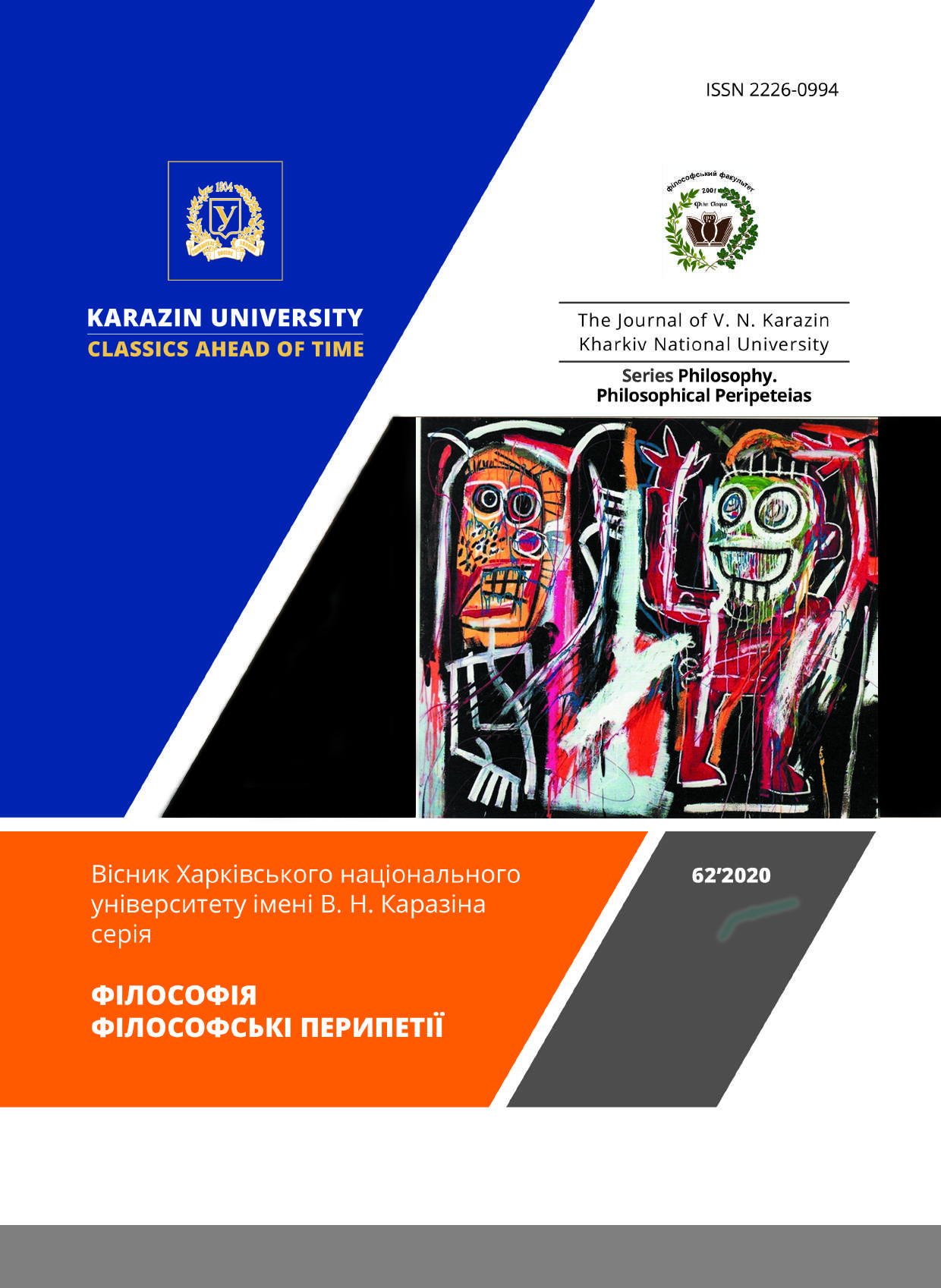DARK MATTER OF IMAGES IN THE SITUATION OF CONTAGIOUS RESONANCE
Abstract
The article conceptualizes the ontological separation in the situation of "contagious resonance", which is set in particular by the pandemic. There is a shift in the mass consciousness of the terrifying images that form a kind of "dark matter" of the materialist view of the modern capitalist world and embody in a certain cultural and historical perspective of the paradigm of life, power. Reveals four macro-images characteristic of the coordinate system of the modern world: demon, zombie, vampire and werewolf. They reveal as a kind of substance of this world the separation-partition that allows the following processes: alienation, appropriation, consumption, absorption, exploitation, rotation, assimilation, satisfaction, exchange, information, knowledge, transformation, desolation, infection, vaccination. This is a paradoxical state of mass consciousness caused by a pandemic, when the penetration of "infinitesimally" leads to extraordinary social processes of separation, distancing, alienation, which is represented by horrible macro images, diagrams of which are presented in the article. The main principle of the study is the principle of complementarity, which allows you to build such diagrams, exposing the complementarity, intertwining and compatibility of images of zombies, demons, vampires and werewolves in nonlinear perspective. The diagrammatic approach, therefore, allows you to highlight the eerie, incredible as everyday.
Zombies and vampires are presented as paradigmatic for (post)modern culture, characterized by a special boundary state between death and immortality. The demon and the werewolf return the fears inherent in the pre-capitalist, archaic image of the world, when man was placed between the divine and animal dimensions. It is noted that the zombie figure embodies the grassroots phenomena of today: dead labor, industrial exploitation, consumerism, mass infection, advertising, information. A vampire marks a class gap and is the epitome of choice and the privilege it confers. The demon and the werewolf represent the fears present in the conservative and ecological consciousness. The article identifies four transversals that dissect the multiplicity of processes characteristic of modern society: zombies / infection, which characterizes the processes of transmission of everything from information to virus, vampire / vaccination as access to a set of privileges, demon / desolation, as separation of mental and physical , werewolves / transformations as interpenetration of different types of life.
Downloads
References
Auerbach, N. (1997). Our Vampires, Ourselves. Chicago: University Of Chicago Press.
COVID-19 misinformation. In Wikipedia. Retrieved from https://en.wikipedia.org/wiki/COVID-19_misinformation
Hubner, L., Leaning, M., Manning, P. (Edit.) (2015). The Zombie Renaissance in Popular Culture. New York: Palgrave Macmillan.
Irwin, W., Housel, R., Wisnewski, J. (Edit.) (2009). Twilight and Philosophy: Vampires, Vegetarians, and the Pursuit of Immortality. New Jersey: John Wiley & Sons, Inc.
Khrabrova, O. V. (2020). Zombie as a flesh of (post)capitalism. The Journal of V. N. Karazin Kharkiv National University, Series "Philosophy. Philosophical Peripeteias, (62), 25-32. https://doi.org/10.26565/2226-0994-2020-62-3 (Іn Ukrainian).
Kirk, R. (2019). Zombies. The Stanford Encyclopedia of Philosophy (First published Mon Sep 8, 2003; substantive revision Tue Mar 19, 2019); Edward N. Zalta (ed.). URL : https://plato.stanford.edu/entries/zombies/#ZombPhys
Lacanalia. 2010. No. 3. Capital-Vampire. URL: http://lacan.ru/wp-content/uploads/2017/08/lcn003_capitalvampire.pdf (In Russian).
Latour, Br. (2001). Pasteur: War and Peace of Microbes, followed by Irréductions. Paris: La Découverte, «Sciences humaines et sociales», 2001. (In France)
Lauro, S. J. (Edit.) (2017). Zombie theory: a reader. Minneapolis: University of Minnesota Press.
Murphy, K. (Edit.) (2019). The Zombie Reader. University of Colorado; Boulder: Cognella, Inc.
Packer, S., Pennington, J. (Edit.) (2014). A History of Evil in Popular Culture: What Hannibal Lecter, Stephen King, and Vampires Reveal about America. Volume 1: Evil in Film, Television, and Music. Santa Barbara: Praeger.
Perepelytsia, O. M. (2017). THE METAMORPHOSES OF THE SUBJECT: OF/AFTER COGITO BEFORE/AFTER LIBIDO. The Journal of V. N. Karazin Kharkiv National University, Series "Philosophy. Philosophical Peripeteias, (56), 9-14. https://doi.org/10.26565/2226-0994-2017-56-2. (Іn Ukrainian).
Perepelytsia, O. M., Khrabrova O. V. (2018). Werewolf: the eternal return of human / beast. G.S. Skovoroda creativity as a metatext of Ukrainian culture. In memory of Myroslav Popovych: Materials of the XXVI Kharkiv International Skovoroda Readings (OKS "National Literary Memorial Museum of G.S. Skovoroda, September 28-29, 2018). Kharkiv: Maidan. 296-302. (Іn Ukrainian).
Petzoldt, R. (1997). The Comeback of the Vampires: The History of the Motif from Medieval Legends to Contemporary Literature. Demons: Mediators between This world and the Other Essays on Demonic Beings from the Middle Ages to the Present. Frankfurt am Main; Berlin; Bern; New York; Paris; Wien: Lang. p. 153-164.
Robinson, S. (2011). Blood will tell: vampires as political metaphors before World War I. Boston: Academic Studies Press.
Romero, G. (2014). Empire of the Dead. № 002. Marvel.
Roy, A. (2020). The Pandemic is a Portal. Financial Times, April 3. Available here: https://www.ft.com/content/10d8f5e8-74eb-11ea-95fe-fcd274e920ca
Thacker, Е. (2006). Cryptobiologies. Artnodes. Issue 6. URL: https://raco.cat/index.php/Artnodes/article/view/53107/479852
Thacker, E. (2017). Horror of Philosophy: in. 3 v. V. 1: In The Dust Of This Planet. Perm: HylePress. (In Russian).
Thacker, Е. (2005). Living Dead Networks. The Fibreculture Journal. Issue 4. URL http://four.fibreculturejournal.org/fcj-018-living-dead-networks/.
Copyright (c) 2021 Олег Перепелиця, Ольга Храброва

This work is licensed under a Creative Commons Attribution 4.0 International License.
Authors who publish with this journal agree to the following terms:
- Authors retain copyright and grant the journal right of first publication of this work under the terms of a license Creative Commons Attribution License 4.0 International (CC BY 4.0).
- Authors are able to enter into separate, additional contractual arrangements for the non-exclusive distribution of the journal's published version of the work (e.g., post it to an institutional repository or publish it in a book), with an acknowledgement of its initial publication in this journal.
- Authors are permitted and encouraged to post their work online (e.g., in institutional repositories or on their website) prior to and during the submission process, as it can lead to productive exchanges, as well as earlier and greater citation of published work.






3.gif)




